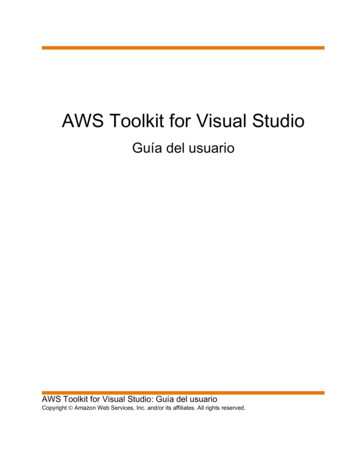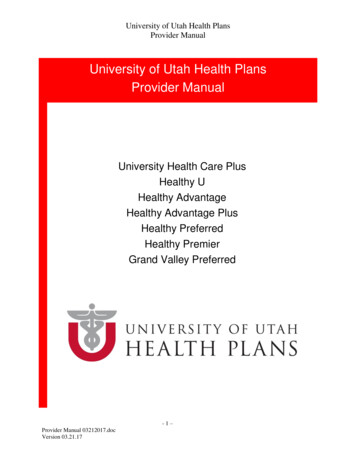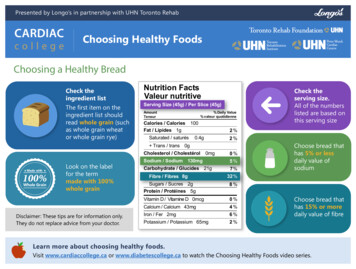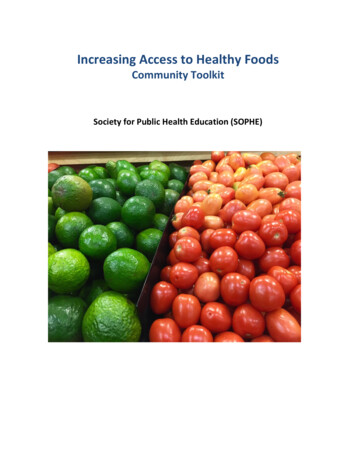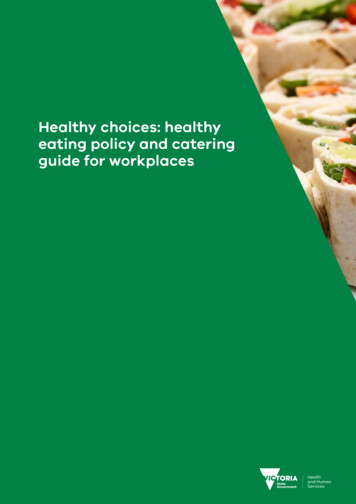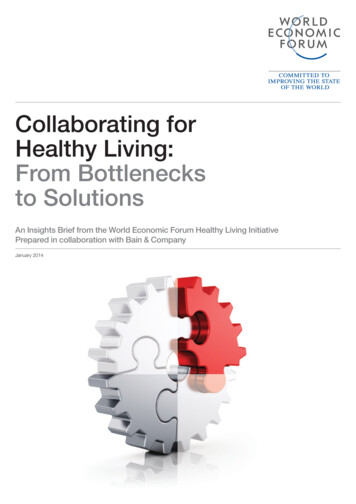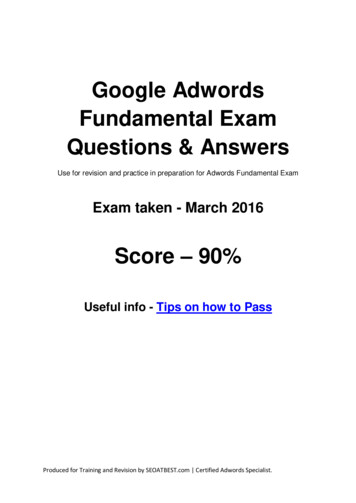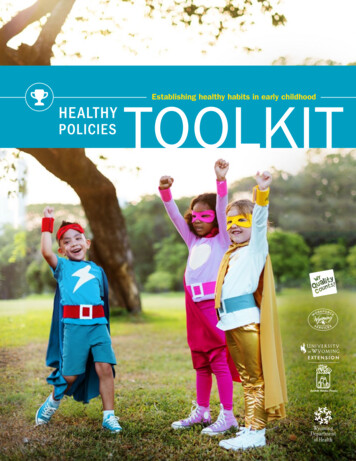
Transcription
Establishing healthy habits in early childhoodHEALTHYPOLICIESTOOLKIT
Establishing healthy habits in early childhoodHEALTHYPOLICIESTOOLKITTABLE OF CONTENTSForeword . . . . . . . . . . . . . . . . . . . . . . . . . . . . . . . . . . . 2Purpose & Acknowledgments . . . . . . . . . . . . . . . . . . . . . . . 3Why You Need Healthy Child Care Policies . . . . . . . . . . . . . . . . 4Using This Healthy Policies Toolkit . . . . . . . . . . . . . . . . . . . . 5Self-Assessment Checklist: Healthy Eating . . . . . . . . . . . . . . .6Self-Assessment Checklist: Physical Activity . . . . . . . . . . . . . .7Model Policies Chart . . . . . . . . . . . . . . . . . . . . . . . . . . . .8Policy Area: Healthy Beverages . . . . . . . . . . . . . . . . . . . . . . 9Policy Area: Healthy Food . . . . . . . . . . . . . . . . . . . . . . . . . 17Policy Area: Healthy Feeding Practices . . . . . . . . . . . . . . . . .21Policy Area: Physical Activity . . . . . . . . . . . . . . . . . . . . . . . 23Resources . . . . . . . . . . . . . . . . . . . . . . . . . . . . . . . . .29
HE ALTHY POLICIESFOREWORD TOOLKITFOREWORDGenetic factors are difficult to change. However,people and places can play a role in helping childrenachieve and maintain a healthy weight. Changes in theenvironments where young people spend their time—like homes, schools, and community settings—canmake it easier for youth to access nutritious foods andbe physically active. Caregivers can adopt policies andpractices that help young people eat more fruits andvegetables, eat fewer foods and beverages that arehigh in added sugars or solid fats, and increase dailyminutes of physical activity. These kinds of programsand policies can be cost-effective and even costsaving.The percentage of children and adolescents who areaffected by obesity in the United States has morethan tripled since the 1970s, according to the nationalCenters for Disease Control and Prevention (CDC).1Further, a 2015-2016 study showed that nearly one infive school-aged children and young people (aged 6 to19 years) in the United States is obese.2Many factors contribute to childhood obesity,including:\\ Genetics\\ Metabolism—how your body changes food andoxygen into energy it can useSource: www.cdc.gov/healthyschools/obesity/facts.htm.\\ Eating and physical activity behaviors\\ Community and neighborhood design and safety\\ Short sleep duration\\ Negative childhood eventsFryar CD, Carroll MD, Ogden CL. Prevalenceof overweight and obesity among children andadolescents: United States, 1963-1965 through 20112012. Health E-Stats.2014. https://www.cdc.gov/nchs/data/hestat/obesity child 11 12/obesity child 11 12.htm. Accessed December 21, 2017.1Hales CM, Carroll MD, Fryar CD, Ogden CL. Prevalenceof obesity among adults and youth: United States,2015–2016. NCHS Data Brief. 2017;288:1–8.22
HE ALTHY POLICIES TOOLKITPURPOSE & ACKNOWLEDGMENTSPURPOSEThe purpose of the Healthy Policies Toolkit is to serveas a policy change tool for child care centers and otherentities providing services for children birth throughage eight.At the time of production, a recognition program wasimplemented to recognize centers and schools whoadopted healthy policies and practices.The toolkit includes:These policies incorporate recommendations from theCenters for Disease Control and Prevention (CDC),the National Association for the Education of YoungChildren (NAEYC), and the Nemours Hospital Systemto encourage children and their families to take simplesteps to improve their own health and reduce theimpact of long-term chronic health conditions in ourcommunities.\\ Self-Assessment Checklist: Healthy Eating\\ Self-Assessment Checklist: Physical Activity\\ Model Policies Chart\\ Customizable Sample PoliciesThis toolkit provides easy-to-use activities that areintended to increase physical activity and promotehealthy food choices within centers or schools. Thisresource includes a self-assessment for programs touse. Additionally, each model policy includes guidancefor adoption and tips for programs to consider whenimplementing policy changes. Adoption of any of themodel policies is voluntary and optional.ACKNOWLEDGEMENTSWith deep gratitude we acknowledge the contributors to this project who dedicated their time to develop this toolkit.This toolkit would not have been possible without the groundwork completed through the University of Washingtonwhich allowed our team to build upon their efforts and adapt the tools for use in Wyoming.In 2019, this toolkit was funded by the WY Quality Counts Program located in the Department of WorkforceServices, and the Maternal and Child Health Unit of the Wyoming Department of Health, through the Title VMaternal and Child Health Services Block Grant Program.This toolkit was vetted and created in consultation with the University of Wyoming Extension Cen ible NutritionProgram and the Wyoming Department of Health Chronic Disease Program.3
HE ALTHY POLICIESWHY TOOLKITWHY YOU NEED HEALTHY CHILD CAREPOLICIES IN EARLY CHILDHOOD SETTINGSPolicies establish the daily practices used in your center or school. Ensuring that yourprogram follows consistent, healthy practices will help your children develop healthfulhabits. Healthy policies also provide specific standards for staff and families to follow,creating an environment that supports healthy behaviors.Establishing healthy policies benefits your centeror school by helping to:\\ Set clear guidelines to minimize misunderstandingsamong staff and parents. Different types ofprograms need different types of policies. Forexample, where and how food is purchased, whattypes of foods are purchased, the equipmentavailable, the number of staff available at mealtime, available outdoor space and the physicalindoor space of your child care program allinfluence the types of policies that make sense foryour program\\ Identify your child care program’s plan for qualitynutrition and physical activity\\ Explain the benefits of your child care program topotential families\\ Demonstrate your program’s commitment tochildren’s health and well-being\\ Educate families regarding your program’s nutritionpractices and the importance of physical activity\\ Ensure that practices in your child care programalign with best practices based on current science,public health research and national healthrecommendations4
HE ALTHY POLICIES TOOLKITUSING THIS KITUSING THIS HEALTHYPOLICIES TOOLKITThis toolkit is designed for your use. The toolkit contains seven model nutrition policiesand three model physical activity policies that correspond to the Healthy Kids,Healthy Future goals. Each model policy is presented with key information aboutwhy it is an important policy, tips for successfully following the policy, and key resourcesfor further exploration. An action planning worksheet is available after each modelpolicy to guide you through the process of adopting the policy.Here are some ideas for places to share yourpolicies with staff and families:Actively adopting the policies outlined in this toolkitmake your child care center eligible for a Certificate ofRecognition from the Wyoming Department of HealthState Health Officer and Wyoming Department ofWorkforce Services Director. Visit www.wyhealthykids.com to receive this certification and additionalresources.\\ Welcome packet for new families\\ Staff handbook\\ Parent handbook\\ Health PolicySTEP 1:\\ WebsiteComplete the Self-Assessment Checklist: HealthyEating.\\ Parent newslettersSTEP 2:\\ Bulletin board or postersComplete the Self-Assessment Checklist: PhysicalActivity.\\ Meetings with parentsSTEP 3:Make sure to review and revise your policies inorder to stay current with any new regulations andbest practice guidance. Take time to reflect on yourexperiences of using the policies in your program andthink about whether any adjustments are needed.Reviewing your policies once a year will ensure thatyou are providing the healthiest care to the childrenyou serve.\\ Promotional material for your programTurn to page 8 to find the Model Policy that correspondsto the Best Practices you marked as either “Fullymeeting ” “Making progress on ” or “Ready to getstarted ” and go to the page(s) listed.STEP 4:Read about the Model Policy and decide whether youare ready to make the change. Answer the question,“Are you ready to adopt this policy?” If you answer “yes”or “maybe,” TAKE ACTION and use the Action Steps toguide you through the process of adopting the policy.Once you have your new policies in place, remember toshare them so everyone knows what your practices are.5
HE ALTHY POLICIESHE ALTHY E ATING CHECKLIST TOOLKITHEALTHY EATING CHECKLISTComplete the Self-Assessment Checklists on the next two pages to get started!Yes, fullymeeting thisbest practiceMaking progresson meeting thisbest practiceReady to getstarted onmeeting thisbest practiceUnable to workon meeting thisbest practiceDrinking water is visible andavailable inside and outside forself-serve 100% fruit juice is served nomore than twice a week in 4-6 oz.portions or never served Sugary drinks, such as fruit drinks,sports drinks, sweet tea, and soda,are never served Children 2 years and older areserved only 1% or skim/non-fatmilk (unless otherwise directed bythe child’s health provider) Fruits and vegetables are servedat every meal (french fries, tator tots,and hash browns don’t count asvegetables) French fries, tator tots, hashbrowns, potato chips, or other friedor pre-fried potatoes are served nomore than once a month or never Chicken nuggets, fish sticks, andother fried or pre-fried frozen andbreaded meats or fish are servedno more than once a month ornever All meals are served family styleand children are encouraged toserve themselves with limited help BEST PRACTICES6
HE ALTHY POLICIES TOOLKITPHYSICAL ACTIVIT Y CHECKLISTPHYSICAL ACTIVITY CHECKLISTBEST PRACTICESPreschoolers are provided with 120minutes or more of active play timeevery day, both indoor and outdoorYes, fullymeeting thisbest practiceMaking progresson meeting thisbest practiceReady to getstarted onmeeting thisbest practiceUnable to workon meeting thisbest practice (for half-day programs, 60 minutes ormore is provided for active play daily)Toddlers are provided with 60-90minutes or more of active play timeevery day, both indoor and outdoor(for half-day programs, 30 minutes ormore is provided for active play daily)Screen time (e.g., TV and DVDviewing, computer use) is limitedto no more than 30 minutes perweek for preschoolers(for half-day programs, screen timeis limited to no more than 15 minutesper week or never)No screen time for toddlers andinfantsAnswer if you serve INFANTSShort supervised periods oftummy time are provided for allinfants several times each day 7
HE ALTHY POLICIESPOLICIES CHARTMODEL POLICIES CHARTPOLICY AREA: Healthy BeveragesPageMODEL POLICY 1Drinking water is available at all times for self-serve, bothindoors and outdoors.9MODEL POLICY 2Sugary drinks are never served.11MODEL POLICY 3100% fruit juice is served no more than twice a week in 4-6oz. portions.13MODEL POLICY 4Only skim or 1% low-fat milk is served to children age 2and older.15POLICY AREA: Healthy FoodPageMODEL POLICY 5Fruits and vegetables are served at every meal and snack.17MODEL POLICY 6Fried foods are offered no more than once a month.19POLICY AREA: Healthy Feeding PracticesMODEL POLICY 7Meals are served family-style and children decide how muchthey eat.POLICY AREA: Physical ActivityPage21PageMODEL POLICY 8Preschoolers get at least 120 minutes and toddlers getat least 60-90 minutes of active play time every day, bothindoor and outdoor.23MODEL POLICY 9Screen time is limited to no more than 30 minutes per weekfor preschoolers and there is no screen time for toddlers andinfants.25MODEL POLICY 10Short supervised periods of tummy time are provided for allinfants several times each day.278 TOOLKIT
POLICY AREA:HEALTHY BEVERAGESHEALTHY BEVERAGESPOLICY AREA
HE ALTHY POLICIES TOOLKITPOLICY ARE A: HE ALTHY BE VER AGESMODEL POLICY 1Drinking water is available at all times for self-serve, both indoors and outdoors.THE IMPORTANCE OF DRINKING WATERKEY RESOURCES:Children need to drink fluids throughout the dayto stay hydrated. Plain drinking water is the bestbeverage choice for thirst. Tap water is a greatsource of free, quality drinking water, and if your tapwater is fluoridated, it also helps to prevent cavities.It is important to encourage children to drink waterthroughout the day because sometimes children don’tnotice they are thirsty. Making it easy for children toaccess water helps them learn to respond to theirthirst with water - a great healthy habit to build!\\ Healthy Beverages in Child ygoals/provide-healthy-beverages/IS THIS A POLICY YOU ARE READY TO ADOPT INYOUR CENTER? Yes Maybe Not nowTIPS FOR SUCCESS:\\ Use kid-friendly pitchers and cups to make it easyfor children to pour and drink water \\ Only fill water pitchers halfway and use lids to avoidUse the Action Steps (1-3)on the next page to guide youthrough the process ofadopting this policy.spills; or, invest in a refillable water cooler with aspout and provide cups\\ Many areas have excellent tap water; if you don’t,consider tap or pitcher-type filters\\ Encourage children to drink water throughout theday, especially after physical activity\\ Be a role model and drink water throughout theday too\\ Offer children water whenever they are thirsty9
HE ALTHY POLICIESPOLICY ARE A: HE ALTHY BE VER AGES1. TOOLKITReview your program’s current practices (with staff, if applicable) and identify practices that are not consistentwith the new policy you want to adopt.\\ What current practices at your program relate to this policy?\\ What would need to change if you adopted this policy?2.Identify and address barriers to change (with your staff, if applicable).\\ What are barriers to adopting this policy? List ideas for getting around the barriers.3.Develop an action plan for adopting the policy. Identify who will be responsible for making changes and by whatdate. Review the action plan on the due date to keep track of changes.What actions need to be taken?Who will be responsible?By what date?WE’RE ADOPTING HEALTHY POLICY 1: THE IMPORTANCE OF DRINKING WATER!Actively adopting the policies outlined in this toolkit will help make your child care centeror school a healthy, wholesome environment for your children to thrive.Visit www.wyhealthykids.com to learn more.10
HE ALTHY POLICIES TOOLKITPOLICY ARE A: HE ALTHY BE VER AGESMODEL POLICY 2Sugary drinks are never served.THE IMPORTANCE OF ELIMINATINGSUGARY DRINKSKEY RESOURCES\\ Healthy Beverages in Child ygoals/provide-healthy-beverages/Sugary drinks such as fruit drinks, sports drinks,sweet tea, flavored milks and waters, and soda arefull of “empty calories” which means they are highin calories but are very low in nutrients. Foods andbeverages with empty calories are not a good choicefor young children who need nutrients for growth anddevelopment. Consuming sugary drinks may causeexcess weight gain, tooth decay, and obesityin children.\\ Childhood Nutrition mIS THIS A POLICY YOU ARE READY TO ADOPT INYOUR CENTER? YesTIPS FOR SUCCESS: Maybe\\ Don’t have sugary drinks onsite; if kids can’t see Not nowthem, they are less likely to ask for them\\ Communicate with parents about your commitmentto their children’s health and the importance of notserving sugary drinks Use the Action Steps (1-3)on the next page to guide youthrough the process ofadopting this policy.\\ Ask parents not to send sugary drinks to child care;include this in your parent handbook\\ Offer water and milk as alternatives to sugarydrinks\\ Be a role model and don’t consume sugary drinksin front of the children11
HE ALTHY POLICIESPOLICY ARE A: HE ALTHY BE VER AGES1. TOOLKITReview your program’s current practices (with staff, if applicable) and identify practices that are not consistentwith the new policy you want to adopt.\\ What current practices at your program relate to this policy?\\ What would need to change if you adopted this policy?2.Identify and address barriers to change (with your staff, if applicable).\\ What are barriers to adopting this policy? List ideas for getting around the barriers.3.Develop an action plan for adopting the policy. Identify who will be responsible for making changes and by whatdate. Review the action plan on the due date to keep track of changes.What actions need to be taken?Who will be responsible?By what date?WE’RE ADOPTING HEALTHY POLICY 2: THE IMPORTANCE OF ELIMINATING SUGARY DRINKS!Actively adopting the policies outlined in this toolkit will help make your child care centeror school a healthy, wholesome environment for your children to thrive.Visit www.wyhealthykids.com to learn more.12
HE ALTHY POLICIES TOOLKITPOLICY ARE A: HE ALTHY BE VER AGESMODEL POLICY 3100% juice is served no more than twice a week in 4-6 oz. portions.THE IMPORTANCE OF LIMITING JUICESKEY RESOURCESIn small amounts, 100% juice can be a healthy choicefor children. However, drinking too much juice mayprovide more calories than needed, increasing therisk of obesity in young children. Limiting juice canalso help reduce tooth decay, as the sugars in 100%juice contribute to cavities. Whole fruits and vegetablescontain more nutrients and fiber than 100% juice,making them a healthier choice.\\ Healthy Beverages in Child ygoals/provide-healthy-beverages/IS THIS A POLICY YOU ARE READY TO ADOPT INYOUR CENTER? Yes MaybeTIPS FOR SUCCESS: Not now\\ Review your menus to see how much juice isusually served and during which meals\\ Replace juice in your menu with easy whole fruit and vegetable choices like orange slices,cucumber wheels, or sliced bananaUse the Action Steps (1-3)on the next page to guide youthrough the process ofadopting this policy.\\ Offer water and milk throughout the day insteadof juice\\ Educate your staff about the potential harm ofgiving children too much juice\\ Communicate with parents about the importanceof limiting juice intake13
HE ALTHY POLICIESPOLICY ARE A: HE ALTHY BE VER AGES1. TOOLKITReview your program’s current practices (with staff, if applicable) and identify practices that are not consistentwith the new policy you want to adopt.\\ What current practices at your program relate to this policy?\\ What would need to change if you adopted this policy?2.Identify and address barriers to change (with your staff, if applicable).\\ What are barriers to adopting this policy? List ideas for getting around the barriers.3.Develop an action plan for adopting the policy. Identify who will be responsible for making changes and by whatdate. Review the action plan on the due date to keep track of changes.What actions need to be taken?Who will be responsible?By what date?WE’RE ADOPTING HEALTHY POLICY 3: THE IMPORTANCE OF LIMITING JUICES!Actively adopting the policies outlined in this toolkit will help make your child care centeror school a healthy, wholesome environment for your children to thrive.Visit www.wyhealthykids.com to learn more.14
HE ALTHY POLICIES TOOLKITPOLICY ARE A: HE ALTHY BE VER AGESMODEL POLICY 4Only skim or 1% low-fat milk is served to children ages two and older.THE IMPORTANCE OF LOW-FAT MILKKEY RESOURCESMilk is a healthy beverage choice because it providesmany important nutrients, such as protein, calcium,and vitamin D. Infants need plenty of fat for optimalbrain development, but after age two, children do notneed as much fat in their diet. Limiting high fat dairyproducts is an easy way to avoid excess calorie andfat intake. Low fat dairy products such as non-fat(skim) and 1% low-fat milk contain all the healthynutrients of higher fat milks with fewer calories andless saturated fat.\\ Healthy Beverages in Child ygoals/provide-healthy-beverages/IS THIS A POLICY YOU ARE READY TO ADOPT INYOUR CENTER? Yes Maybe Not nowTIPS FOR SUCCESS:\\ Try making the switch; most children won’t noticethe difference\\ If you are worried that children won’t like the lower fat milk, you can try easing into it by mixingwhole or 2% milk with skim or 1% milk, graduallydecreasing the amount of higher fat milk overseveral daysUse the Action Steps (1-3)on the next page to guide youthrough the process ofadopting this policy.\\ Educate your staff about the benefits of givingchildren over age two lower fat milk\\ Communicate with parents about the safety andhealth benefits of lower fat milk15
HE ALTHY POLICIESPOLICY ARE A: HE ALTHY BE VER AGES1. TOOLKITReview your program’s current practices (with staff, if applicable) and identify practices that are not consistentwith the new policy you want to adopt.\\ What current practices at your program relate to this policy?\\ What would need to change if you adopted this policy?2.Identify and address barriers to change (with your staff, if applicable).\\ What are barriers to adopting this policy? List ideas for getting around the barriers.3.Develop an action plan for adopting the policy. Identify who will be responsible for making changes and by whatdate. Review the action plan on the due date to keep track of changes.What actions need to be taken?Who will be responsible?By what date?WE’RE ADOPTING HEALTHY POLICY 4: THE IMPORTANCE OF LOW-FAT MILK!Actively adopting the policies outlined in this toolkit will help make your child care centeror school a healthy, wholesome environment for your children to thrive.Visit www.wyhealthykids.com to learn more.16
POLICY AREAPOLICY AREA:HEALTHY FOODHEALTHY FOOD
HE ALTHY POLICIES TOOLKITPOLICY ARE A: HE ALTHY FOODMODEL POLICY 5Fruits and vegetables are served at every meal and snack.THE IMPORTANCE OF FRUITS AND VEGETABLESKEY RESOURCESFruits and vegetables contain lots of nutrients and arelow in calories. Young children need a variety of fruitsand vegetables every day for growth and development,but studies show that many children don’t get therecommended amount. Fruits and vegetables are agreat way to expose children to new tastes, textures,and colors. Although children may refuse unfamiliarfood, and though it can take up to 10 tries before achild will accept a new food, it’s important to keepoffering a variety of fruits and vegetables so childrenhave an opportunity to try different kinds, make themfamiliar and get the nutrients they need.\\ Grow It, Try It, Like It! Preschool Fun with Fruitsand Vegetables- a garden-themed nutritioneducation kit from USDA: /growit book1.pdf\\ USDA’s Daily Food Plan for Preschoolers, VaryYour Veggies: www.choosemyplate.gov/preschoolers-food-groups\\ Avoid choking hazards: www.choosemyplate.gov/preschoolers-food-safetyTIPS FOR SUCCESS:IS THIS A POLICY YOU ARE READY TO ADOPT INYOUR CENTER?\\ Use color as your guide when planning menus and Yesmake it a goal to include vegetables of all colorsduring the week Maybe Not now\\ Try serving veggies with yogurt, hummus, or low-fat dressing for dipping \\ Watching others around them eat foods they aren’tsure about can help a child decide to try a newfood, so remember to be a role model and eat thefruits and veggies you serveUse the Action Steps (1-3)on the next page to guide youthrough the process ofadopting this policy.\\ Teach children about different fruits and vegetables:where they come from; how they grow; how theylook, taste, feel, sound, and smell; discoveringand learning about fruits and vegetables can helpchildren develop a positive relationship with them\\ Communicate with parents about the benefits ofoffering children lots of different fruits and veggiesto try17
HE ALTHY POLICIESPOLICY ARE A: HE ALTHY FOOD1. TOOLKITReview your program’s current practices (with staff, if applicable) and identify practices that are not consistentwith the new policy you want to adopt.\\ What current practices at your program relate to this policy?\\ What would need to change if you adopted this policy?2.Identify and address barriers to change (with your staff, if applicable).\\ What are barriers to adopting this policy? List ideas for getting around the barriers.3.Develop an action plan for adopting the policy. Identify who will be responsible for making changes and by whatdate. Review the action plan on the due date to keep track of changes.What actions need to be taken?Who will be responsible?By what date?WE’RE ADOPTING HEALTHY POLICY 5: THE IMPORTANCE OF FRUITS AND VEGETABLES!Actively adopting the policies outlined in this toolkit will help make your child care centeror school a healthy, wholesome environment for your children to thrive.Visit www.wyhealthykids.com to learn more.18
HE ALTHY POLICIES TOOLKITPOLICY ARE A: HE ALTHY FOODMODEL POLICY 6Fried foods are served no more than once a month.THE IMPORTANCE OF LIMITING FRIED FOODSKEY RESOURCESFried foods are high in fat (usually unhealthy saturatedor trans-fat), calories, and sodium (salt) but very lowin nutrients. This includes fried vegetables like fries,tater tots, potato chips, onion rings, or fried okra, aswell as fried meats such as chicken nuggets, fishsticks, and other breaded and frozen foods. Theseare not healthy choices for children: too many caloriescan cause excess weight gain, unhealthy fats canlead to heart disease, and excess salt can contributeto hypertension. Young children need to eat a varietyof colorful vegetables and lean protein to get thenutrients they need for growth and development.\\ Washington Grown Food Kit- healthy recipes forchild care programs searchable by recipes inseason, sample menus, and nutrition facts:www.wafarmtoschool.org/ToolKit\\ Tips for choosing protein foods for preschoolers:www.choosemyplate.gov/protein-foodsIS THIS A POLICY YOU ARE READY TO ADOPT INYOUR CENTER? Yes Maybe Not nowTIPS FOR SUCCESS:\\ In place of frying, try healthier cooking methods:braise, bake, steam, grill, or poach \\ Watch out for pre-fried foods, including refrigeratedUse the Action Steps (1-3)on the next page to guide youthrough the process ofadopting this policy.or frozen items that are breaded or battered anddescribed as “crispy” or “crunchy”\\ To provide the most variety, try serving lots ofdifferent veggies, not just potatoes\\ Get creative with protein sources and try addingsome meat alternatives like beans to the menu\\ Find ways for the children to help prepare thefood; younger children can add premeasuredingredients, stir, and name foods, and older kidscan help assemble food, measure ingredients andpeel eggs and fruit19
HE ALTHY POLICIESPOLICY ARE A: HE ALTHY FOOD1. TOOLKITReview your program’s current practices (with staff, if applicable) and identify practices that are not consistentwith the new policy you want to adopt.\\ What current practices at your program relate to this policy?\\ What would need to change if you adopted this policy?2.Identify and address barriers to change (with your staff, if applicable).\\ What are barriers to adopting this policy? List ideas for getting around the barriers.3.Develop an action plan for adopting the policy. Identify who will be responsible for making changes and by whatdate. Review the action plan on the due date to keep track of changes.What actions need to be taken?Who will be responsible?By what date?WE’RE ADOPTING HEALTHY POLICY 6: THE IMPORTANCE OF LIMITING FRIED FOODS!Actively adopting the policies outlined in this toolkit will help make your child care centeror school a healthy, wholesome environment for your children to thrive.Visit www.wyhealthykids.com to learn more.20
POLICY AREAHEALTHY FEEDINGPRACTICESPOLICY AREA:HEALTHY FEEDING PRACTICES
HE ALTHY POLICIES TOOLKITPOLICY ARE A: HE ALTHY FEEDING PR ACTICESMODEL POLICY 7Meals are served family-style* and children decide how much they eat.THE IMPORTANCE OF FAMILY-STYLE MEALSKEY RESOURCESServing meals family-style creates an opportunity forchildren to practice many new skills, including learningto serve and pass food, waiting their turn, and othertable manners. When children serve themselves anddecide how much to eat, they practice paying attentionto their internal hunger and fullness cues. Creatinghealthy feeding practices is especially important foryoung children because they are trying many foodsfor the first time, forming food preferences, learningself-feeding skills, and beginning to follow social cuesabout eating.\\ Tips and resources for family-style tipsfor-family-style-dining/\\ Guide for starting family-style dining, includingequipment checklist, tips for success, and waysto communicate with parents about the t/files/sfsp/SMT-FamilyStyleMeals.pdfIS THIS A POLICY YOU ARE READY TO ADOPT INYOUR CENTER?*Family-style is a type of meal service where children servethemselves from serving dishes at the table. Children decide ifand how much of the food they serve themselves. At least oneadult should sit at each table of children to offer assistancewhen needed and to set a positive example. Yes Maybe Not nowTIPS FOR SUCCESS:\\ Place food on the table in serving dishes that are easy for children to pick up and pass; usingserving utensils that are “kid-sized” will make theprocess easierUse the Action Steps (1-3)on the next page to guide youthrough the process ofadopting this policy.\\ Sit with the children and eat together, using themeal time for social conversation; t
100% fruit juice is served no more than twice a week in 4-6 oz. portions. 13 MODEL POLICY 4 Only skim or 1% low-fat milk is served to children age 2 and older. 15 POLICY AREA: Healthy Food Page MODEL POLICY 5 Fruits and vegetables are served at every meal and snack. 17 MODEL POLICY 6 Fried foods are offered no more than once a month. 19




